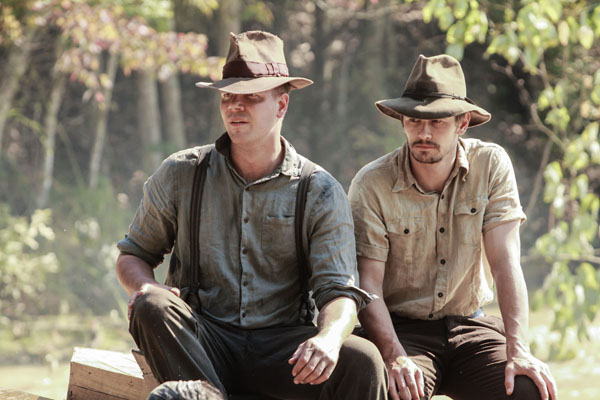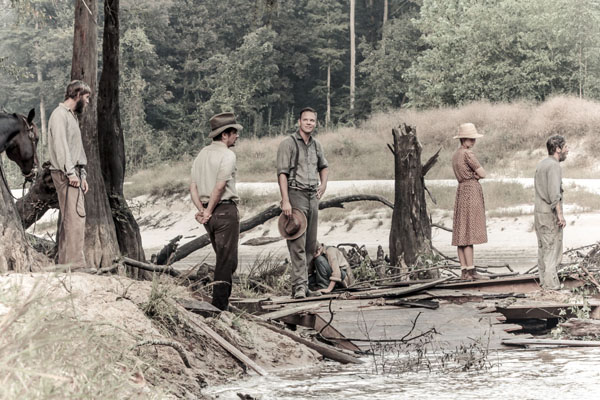“James Franco has pulled off a devilishly difficult literary adaptation with this faithful yet cinematically vibrant version of William Faulkner’s As I Lay Dying,” begins Todd McCarthy in the Hollywood Reporter. “Like the multiple English masters degree holder he is, Franco, with co-scripter Matt Rager, has wrestled to the ground the author’s fragmented, multi-voiced tale of the ordeal an impoverished Mississippi family endures to bury its matriarch and emerged with something many have tried but few have delivered, a worthy screen adaptation of Faulkner. A rarified art film all the way, one that will divide even brainy students and specialized cinema types, this is by a long way the best of the eight features the mind-bogglingly prolific actor-director-writer had made and is, as such, a big surprise.”
“The novel itself is famously narrated by many different characters in separate short chapters,” writes the Guardian‘s Peter Bradshaw, “and it is perhaps to match the spirit of these varying viewpoints that Franco presents so much of the story in split screen. Long, unhurried scenes will unfold, with mumbled, throwaway dialogue, and Franco will have two different frames, left and right: sometimes they will show two differing and significant shots, sometimes hardly more than a fractured version of the same shot. Sometimes they will be two almost exactly similar shots of the same featureless sky, with the non-matching vertical join line almost invisible. This may look gimmicky and self-conscious, but it is consistently and seriously presented, and Franco’s As I Lay Dying is a worthwhile movie, approached in an intelligent and creative spirit.”
“Franco offers up a competently acted, technically adequate Cliff Notes take on Faulkner’s narratively refracted tale,” writes Variety‘s Leslie Felperin, who finds that “it somehow makes sense that Franco should turn to Faulkner’s rapturous, punch-drunk experimentalism, given all the early-to-mid-20th-century existentialist, outsider icons dotting the multihyphenate’s resume: He’s directed celebrations of the poet Hart Crane (The Broken Tower) and tragic thesp Sal Mineo (Sal), while elsewhere he’s played James Dean and Beat master Allen Ginsberg. There are even faint Faulknerian echoes detectable in his short-story collection Palo Alto, with its psychogeographic fixation on South Peninsula suburbia.”
“While the cast tackles the Southern setting with relish, they are often delivering the same single notes,” writes the Playlist‘s Kevin Jagernauth. “Tim Blake Nelson chews on a Southern accent (with literally no teeth and rotting gums) that is often incomprehensible as Anse, the head of the clan; Jim Parrack mostly moans as Cash (and spends an absurd amount of time sawing the same piece of wood in the first section of the film); while Logan Marshall-Green is quietly stoic as the bastard Jewel. Perhaps the lone standout is Ahna O’Reilly as the fresh-faced Dewey Dell, who is on a rather heartbreaking mission to get an abortion. With Franco putting himself in the role of Darl, the ‘main’ character, his accent comes and goes, and his third act histrionics due to a twist (sort of) are absurdly over the top, for what is an otherwise moodily measured picture.”
For Screen‘s Allan Hunter, the use of split-screen “feels distracting and gimmicky without adding anything to the experience,” while Geoffrey Macnab, writing for the Independent, finds it “works well enough. So does cinematographer’s Christina Voros’s handheld camerawork.” And then there’s this: “At its best, the filmmaking evokes memories of Terrence Malick’s Days of Heaven.” Well!
“It’s become a running gag stretched out over the annual festival calendar,” writes Boyd van Hoeij for Indiewire. “Here’s another project (or two, or three…) with and/or by actor-writer-director-artist-celebrity James Franco. Does the man ever sleep? How many James Francos are there?” And: Will the Cannes premiere for As I Lay Dying become “part of the problem, as it allows Franco to move quickly from project to project with celebrity-hungry festivals ready to give him a pass for work that’s just passable?” Ultimately, Boyd decides, “I would argue it has its place in Un Certain Regard.”
On the day that Cannes opened, the Los Angeles Review of Books ran Michael Bibler‘s interview with Franco: “I really felt as if I was in conversation with Faulkner; even though he wasn’t alive, he was alive in his work. So, I tried to make a film that I thought he would appreciate.”
Updates, 5/21: “Oddly,” writes Tom Christie at Thompson on Hollywood, “as the slightly clairvoyant and mad son Darl, this is Franco’s least effective portrayal; he’s there and that’s about it.”
At In Contention, Guy Lodge agrees: “The weakest link in the ensemble, disappointingly, is Franco himself, who retains a smirky remove even during Darl Lundgren’s most emotionally bare scenes—though he does at least give himself the best close-ups. You might say that remove characterizes Franco’s direction, too: sporadically clever as his treatment is, he never seems all that invested in the novel except as a particularly challenging exercise for his ongoing artistic self-invention…. But the task of creating a film even obliquely equal to the rageful literary brazenness of Faulkner remains a hopeless task that Franco, with nothing to lose, should have attacked with the hell-for-leather eccentricity of his more gleefully silly performances and art pieces; As I Lay Dying is the rare film that might have been a bit better for being a bigger failure.”
“More experienced directors than Franco have come to stickier ends adapting ‘unfilmable’ classics, and his chosen split-screen technique is not as gimmicky as it sounds,” writes Catherine Bray for Time Out London. What’s more, “it’s satisfying to see the novel’s set pieces come alive in often visceral sequences including a wagon wreck, amateur first aid, and subsequent rural surgery.”
Chuck Tryon, dispatching to Filmmaker, once wrote a master’s thesis on As I Lay Dying and is pleasantly surprised to find “Franco to be a relatively keen reader, managing to stay true in spirit both to Faulkner’s darkly comic narrative and to his modernist, often fragmentary experiments with point-of-view.”
Also for Filmmaker, Ariston Anderson sits down with Franco and culls “Ten Lessons on Filmmaking.” Logan Hill talks with him, too, for the New York Times.
Updates, 5/22: For Mary Corliss, writing for Time, “As I Lay Dying reveals itself as a successful summer project for a multitasking graduate student.”
Salon‘s Andrew O’Hehir talks with Franco about “what he learned from Robert Altman, Sam Raimi, and Harmony Korine.”
Update, 10/28: Merve Emre talks with Franco and screenwriter Matt Rager for the Los Angeles Review of Books.
Update, 11/16: “In several of the film’s most compelling moments,” writes Joseph Entin for the Los Angeles Review of Books, “Franco offers refreshingly direct access to Faulkner’s monologues, such as Cash’s 13-point explanation of the coffin design or Dewey Dell’s sensuous description of her love affair in the cotton fields, which are delivered in tightly-framed shots of the characters looking unswervingly into the lens. The unconventional filmic techniques may rankle some viewers, but set against the provocative and perplexing nature of Faulkner’s prose, they arguably don’t go far enough.”
Cannes 2013 Index. And you can watch over 100 films that have seen their premieres in Cannes right here on Fandor. For news and tips throughout the day every day, follow @KeyframeDaily on Twitter and/or the RSS feed. Get Keyframe Daily in your inbox by signing in at fandor.com/daily.





